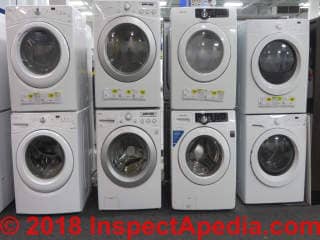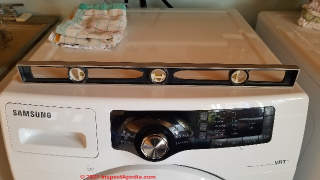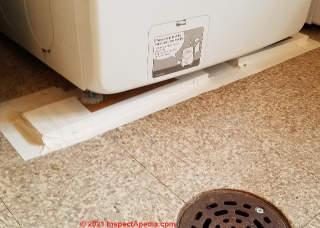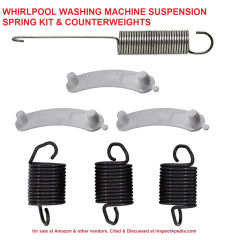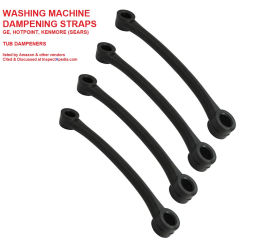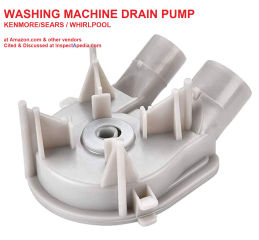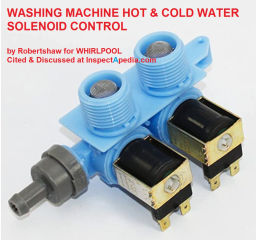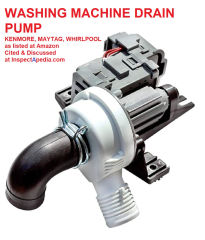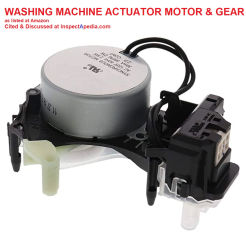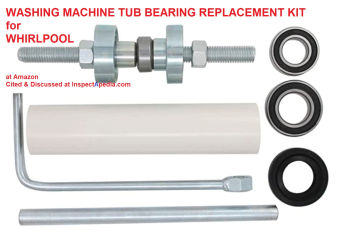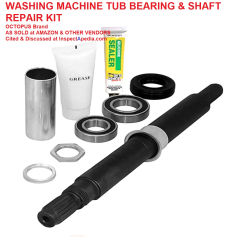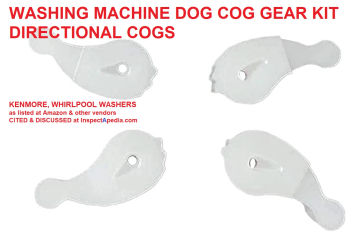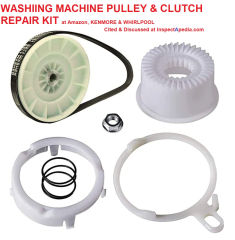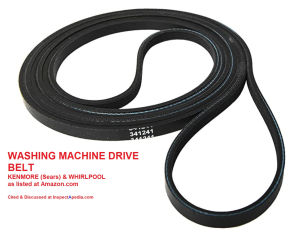 Washing Machine Noise Diagnosis & Repair
Washing Machine Noise Diagnosis & Repair
Trace clothes washer noise to failing part
- POST a QUESTION or COMMENT about washing machine noises: causes & cures
This article describes the noises made by a clothes washing machine, both during normal operation and when a washing machine part is failing or has failed.
We help sort out which of these washing machine noises are most serious, which can be repaired, who can do the repair, and which washing machine failures are probably beyond economical repair.
InspectAPedia tolerates no conflicts of interest. We have no relationship with advertisers, products, or services discussed at this website.
- Daniel Friedman, Publisher/Editor/Author - See WHO ARE WE?
Washing Machine Noises: Causes, Cures, Parts
Strategy for Troubleshooting Washing Machine Noises
Before looking through the different noises that you may hear at or around your clothes washer, let's first note things that can help home in on the noise, its source, and thus it's seriousness, the urgency of repair.
You will see these three properties used to describe different causes and significance of various washing machine noises.
[Click to enlarge any image]
- When does the washing machine noise occur?
At what washing machine cycle? At the start or end of the cycle or during the cycle?
For some of the noise descriptions found below you'll read that just when the noise occurs can tell us its probable cause. - What does the noise sound like? Buzz, clank, vibration, etc?
We list below just about every sound your washing machine may produce.
Some of these are normal, some spell trouble. - How loud is the washing machine noise?
Louder noises are often a sign of more-serious washing machine trouble, but some loud clunks are normal.
Watch out: for safety, before working on or even trying to move a washing machine remember to turn off its water supply and to disconnect it from electrical power.
Watch out: while we describe washing machine parts that are most-likely to be a source of noise, giving photos of most of them, many of these failures are not cost-reasonable to repair, most require repair by a trained washing machine service technician, and even if you are ready and able to try a repair, don't buy the example repair parts we show here before checking that the part is specifically designed to fit your particular washing machine brand and model.
Common Normal Washing Machine Noises
Normal washing machine noises during agitation and spin include the motor sound and of course the tub spinning and water entering or exiting the washer.
Other normal washing machine noises include clicks and even clunks as the washer steps between cycles or when its electric solenoid valves open or close to admit water to the tub or drum, or when its pump begins to empty water at the end of a wash or rinse cycle.
Diagnostic List of Washing Machine Noises / Sounds
Below, in alphabetical order we list common washing machine noises and give diagnosis and repair suggestions.
Don't worry if you're not sure whether to call a noise vibration, grinding, clicks or clunks. People's characterization of sounds varies considerably. Just look through the list below.
1. Washing Machine Banging Noises
Watch out: If the banging is very loud turn off the washer to stop possible damage, then check out the possible causes in this list.
- Balance the washing machine load: Check first for a badly un-balanced load in the washer during a spin cycle. Turn the machine OFF and when its tub has stopped spinning pull out and re-distribute the wet contents as uniformly as you can around the tub.
- Level the washing machine & check its feet for damage or loose lock-nuts
After balancing the load in your washing machine, and before turning the washer back on, double check that all four of its feet are equally tight against the floor.
If you can "rock" the washing machine back and forth or side to side then one or more of its feet are not properly extended.
Washing machines have screw-down feet, often with a lock nut, that permits leveling the machine. If one or two of the feet are improperly-adjusted the machine may wobble and bang about during the spin cycle.
Turning the washing machine foot clockwise to lower the foot, or counterclockwise to raise the foot. When all four feet are equally tight against the floor, tighten the threaded foot-rod lock-nut up against the underside of the washing machine cabinet.
Watch out: a washing machine that's out of balance or whose feet are not properly adjusted can wobble and wiggle its way across the floor, even tearing off its water-hose connections, causing a costly building flood.
Watch out: if the washing machine is leveled and all four of its feet are tight against the floor but it continues to bang and bounce around during the spin cycle AND if it's a front loader then check for a loose or broken drum shock absorber - a replaceable part.
Secure a creeping washing machine on a sloped floor
The washing machine shown above is installed on a sloping (asphalt-asbestos tiled) basement floor of a home built in northern Minnesota in the 1960s. (The washing machine is new.)
Despite careful adjustment of the feet on this washing machine it persists in creeping down-slope on the floor during its spin cycle. Finally in desperation we installed a curb cut out of 3/4" thick wood and taped it to the floor. That has kept the washing machine from marching across the floor for a time.
Less-common Washing Machine Banging Noise Causes
- Washing machine drum or tub bearing bang noise at the start of a spin cycle usually means that the drum bearing has failed and has loose or broken internal parts. As the drum continues to rotate the "bang" may change to a grinding or metallic grinding noise. Drum bearings are not a replaceable part on most washing machines.
The whole tub assembly that includes the agitator and drum bearing are replaced. - Front loading washing machine shock absorber failure: an un-common case of washing machine balance trouble that cause it to bang about: most front-loading washing machines use a shock absorber that supports the rotating drum or tub to keep it centered during the spin cycle.
A front loaded washer whose shock absorber has come loose or that has itself failed will result in a horrible thrashing about of the drum during the spin cycle.
Similarly, some washing machines like GE, Hotpoint, & Kenmore, use rubber dampening straps that can break or (rarely) become disconnected.
- Top loading washing machine suspension rod / spring / counterbalance damage: if the suspension spring has stretched, broken, or come detached or if a counterbalance has been lost, the washing machine tub won't stay centered and will thrash and bang about, especially during the spin cycle.
- Loose or broken counterweights, made of cast pot metal or even concrete on some washing machines, break or become loose. If the counterweights or their mounting brackets are simply loose, tightening their mounting bolts can repair the problem.
- Water hammer banging noises may occur when the washing machine water supply valves open or close. If that's happening
See WATER HAMMER NOISE DIAGNOSE & CURE
2. Washing Machine Buzzing Noises
Normal buzzing noises at the washing machine: some washers provide an end-of-cycle alarm that may be a buzz
Abnormal buzzing noises at the washing machine
- An electrical relay that is failing to open or close. See our notes on water supply and water drain pump solenoids
- An electric motor that cannot start.
- An electrical short circuit (rare at washing machines) may make an arcing, buzzing, zapping sound.
Watch out : If you hear an unexplained buzzing or if you smell burning of any sort, turn the machine (or other suspect equipment) off or un-plug it or if you cannot do so safely, turn its power off at the electrical panel and call an electrician or appliance repair technician.
See details at ELECTRICAL SYSTEM NOISES
Also see BUZZING NOISE DIAGNOSIS for a catalog of other sources of buzzing noises in buildings
3. Washing Machine Clicking or TICKING NOISES
3.1. Normal washing machine clicks and thunks
These noises occur when the machine is about to enter a new cycle or washing step.
Above, a typical washing machine drain pump assembly. This model fits many Kenmore or Whirlpool washing machines.
- A rather loud single click or clank may simply be a relay opening or an electrically-operated water valve opening or closing.
- Loud clicks that occur periodically during the washer spin cycle may be the washer drain pump starting or stopping.
Check the pump for obstructions or clogs; more washer pump symptoms appear in this list at other sounds. - A less-loud single click at the start of the first washing machine cycle on both top-loading and front-loading washers is usually an electronic door lock - a safety device to prevent your curious nine-year old from opening the washer while it's full of water or spinning.
Also see Washing Machine Rattles" in this list. - More quiet clicks and scraping noises at the washing machine may be metal buttons or even quarters or your house keys getting an un-anticipated trip through the washer. (Avoid that if you can).
Watch out: small metal objects in the wash can slide down beneath the agitator and the drum causing a jam or damage.
When that was my car keys [Editor - 2018] I found that the agitator was sticking; by pulling off a cap atop the agitator we exposed the hardware - a giant nut - that could be removed to allow wiggling off the agitator to clean out two decade's worth of lint and coins and keys.
But you may need help from an appliance repair tech as getting off that agitator is difficult on many washers. - A quiet ticking sound at the washing machine is normal if it's simply the machine's timer control moving between two cycles. We often hear a washing machine ticking or clicking sound between the end of the spin cycle and the beginning of the rinse cycle.
Also see TICKING NOISES in BUILDINGS
3.2. Abnormal washing machine clicks
- Solenoid-operated water supply valve failures or jams that prevent the electrically-operated hot or cold water valve from opening or closing properly;
Replacing the washing machine hot, cold, or combined hot & cold water solenoid valve is within the capability of a moderately-handy homeowner or handyman who knows to turn electrical power off and water off first. - Solenoid-operated washer drain pump clicks may also be coming from the washing machine drain pump if small objects (in our case a Barbie shoe) makes it through the drain system and into the valve or in the ejector pump itself.
Except for clearing a part you can see inside the entry to a solenoid-operated drain valve, the solenoid valve that controls water in or out of the machine is not usually field-repairable,
The washing machine drain pump might-be repairable. Most washing machine drain pumps can be ids-assembled for inspection and cleaning or for removing small objects. For most homeowners that will require help from a service technician.
Below: a washing machine drain pump that fits some Kenmore, Maytag, and Whirlpool washing machines.
4. Washing Machine Clunk Sounds
- Normal clunks: These may be normal sounds such as relays that open or close to supply water or activate the drain pump.
- Clunk noise between washer agitation & spin cycle: Some failing washing machine relays may make a louder lower-pitched clunk noise (or possibly grinding sound) when failing, heard when the washer is changing from its agitation cycle over to the spin cycle.
If you are hearing a loud click or clunk at that point in the washing machine cycle progress, check for a failing washing machine actuator.
A washing machine actuator, comprised of a motor and a motor-driven shifter cog or finger, is shown below.
5. Washing Machine Grinding Sounds
- Bad tub bearings: Voted as most-frequent noise-trouble on washing machines, if the tub bearing has failed, in addition to banging, shrieking and even clicking sounds we list here, a bad washing machine tub bearing can also make horrible grinding sounds during agitation or spin cycle.
Broken bits of tub bearings or tub bearing case parts are being further ground-up as the tub rotates.
On some washing machines like some Whirlpool or Kenmore models the tub bearing can be replaced, though replacement is time-consuming and beyond the scope of most homeowners.
Shown above is a washer tub bearing installation kit for many Whirlpool washing machines.
Below is another washing machine tub shaft and bearing repair kit from Octopus, as sold at Amazon & by other suppliers.
- Broken directional dog cog gears: A grinding noise in a top-loading washer that occurs during the agitation cycle but not during spin cycle may be failed directional cog-gears that are worn or have broken teeth.
The cog gears are used in concert with the transmission to cause the top loading washer's tub to rotate back and forth during the wash or "agitation" cycle.
These gears can be replaced by a service technician. Shown above: washing machine directional cog gear replacement parts that fit many washing machines including some models of Crosley, Estate, Inglis, Kenmore, KitchenAid, Maytag and Whirlpool washers.
Some sources describe a grinding or "ratcheting" noise in the washing machine that may be traced to a failing agitator hub or shaft or failing directional cog gears or a failing tub bearing.
- Loose bolts or fasteners: check under and around the washing machine for fallen nuts, bolts, washers that may explain a loose part in the drive system or in a drive belt tensioning spring and shaft.
- Worn washing machine clutch or pulley gear can cause grinding or rattling noises that show up during the spin cycle.
Shown below: a washing machine clutch gear and pulley assembly repair kit that fits several models of Kenmore and Whirlpool washing machines.
6. Washing Machine Humming Noises
A modest or low humming noise may be normal electric motor noise when the clothes washer is operating.
On a top loading washer you'll hear this humming sound during the agitation cycle accompanied by a sloshing or swishing sound as the washing machine tub rotates back and forth.
On a front-loading washer check the door seal to be sure it is perfectly in place.
A front loading washing machine door seal that is askew or out of its track may rub against the drum when the drum is rotating, causing a squeaking or humming sound.
Watch out: if you hear a humming or vibrating sound at the washer and the machine is not actually moving - e.g. its tub should be agitating or spinning and it's not
- the problem may be a failing electric motor. For safety turn the machine off, check that it has not been overloaded with too-heavy materials, and it there's no obvious jam in the tub, leave the machine OFF and call for repair.
Also see HUMMING NOISES in BUILDINGS
7. Washing Machine Rattles or Vibration:
Quiet washing machine rattles can be caused by
- An electric relay such as the door lock that is unable to open or close when it should - check for a door obstruction or a sticking door position sensor switch
- Loose metal objects in the washer tossed about during agitation
- Loose washing machine part that is being jiggled about during the spin cycle if the washing machine's feet are not properly-leveled
- Metal objects on clothing that bang or rattle about during agitation or, less-often, during the spin cycle
- Solenoid valve failures or jams that prevent the electrically-operated hot or cold water valve from opening or closing properly
Loud rattling washing machine noises
- Check for an un-balanced load or uneven washing machine feet adjustments - see our description of how to level the washer - earlier on this page.
Watch out: loud rattling and banging may be due to a seriously out-of balance washer load that was just not bad enough to shut off the machine. Does the agitator assembly wiggle left and right when the washer is off?
- Clothes washer transmission bearing failure - look for a failing clothes washer transmission causing a rattle if the transmission bearings have failed.
Check for oil leakage under the washing machine.
See WASHING MACHINE OIL LEAKS
8. Washing Machine Screeches Screaming Sounds
- Failing bearings: tub (top loader) or drum (front loader) bearing, transmission bearing, electric motor bearings
Watch out: Some washing machine screeching or squeaking might be fixed by lubricating the tub bearing (possible to do) or the transmission bearings (difficult) .
Frankly we don't recommend trying to work on the transmission bearings it if you're not familiar with washing machine repair.
Most washer transmissions are not meant to require homeowner lubrication, and leaving the machine on its side or upside down might actually lead to loss of transmission oil - creating an immediate need for repair by a trained technician.
- Failing drum bearing: Screeching or screaming at the washing machine (other than Harriet, bless her soul) is most likely to occur during the spin cycle and usually tells us that the drum bearing is failing.
Screeching due to a failed tub bearing might have earlier been presaged by rattling or banging noises as some of the round balls or cylindrical bearing rollers fell out of the ruined bearing.
In our OPINION bad bearings will quickly ruin the washing machine by damaging its transmission or other components. It's best to stop using the washer and try for a repair.
- Washer drive belt or pulley failure: Screeching or screaming noises at the washing machine in washers that use a drive belt and pulley between the motor and the transmission may show up when the belt is loose or worn, when a pulley tensioning spring has failed, or (uncommon) when the pulley itself is cracked or worn.
- Washer tub off center: A bad dampening strap, shock absorber, centering spring, suspension rod or counter weights may cause a screeching or screaming sound if the tub or drum is spinning off-center.
Also see our notes above about leveling the washing machine by adjusting its feet. - Failing electric motor bearings.
Watch out: loud high-pitched noises at the washing machine may indicate a failed transmission bearing or drive motor bearing. If so those parts will probably need replacement.
Also see ELECTRIC MOTOR NOISE DIAGNOSIS - Also see SCREAMING NOISES in BUILDINGS
9. Washing Machine Vibration Noises
See washing machine clicking, humming, rattling sound descriptions and diagnoses above; start by checking for an un-balanced load and consider a failing bearing or directional cog gears.
Watch out: this is dangerous.
Washing Machine Noise & Vibration Research
This sampling of research into the causes and cures of washing machine noise makes clear that a tremendous amount of work is ongoing for this topic for which there are literally thousands of research articles. Most focus on vibration caused by rotating washing machine parts.
- Boyraz, Pınar, and Mutlu Gündüz. "Dynamic modeling of a horizontal washing machine and optimization of vibration characteristics using Genetic Algorithms." Mechatronics 23, no. 6 (2013): 581-593.
Abstract:
In this work, a 2D dynamic model of a horizontal axis washing machine is derived regarding the rotation plane in order to examine the vibration characteristics of the spin-cycle and improve the design proposing a new optimization scheme based on Genetic Algorithms (GA).
The dynamic model is numerically simulated and the outputs are validated using experimental vibration data acquired from a test-rig including the drum and the motor of a horizontal-axis washing machine. The measurements are performed using piezo-transducers and a novel measurement scheme is used to obtain displacement values from acceleration data as well as estimating the instantaneous frequency of the rotation with appropriate signal processing.
This study has two main contributions: (i) a new method for design improvement applying GA to optimization of vibration characteristics for the horizontal-axis washing machines, and (ii) a novel measurement method yielding the displacement in 2D and instantaneous frequency of vibration from acceleration data.
While the GA is contributing to passive improvement methods in the field, the novel measurement method opens the way for low-cost diagnosis and active-vibration control of washing machines. - Jiang, Jinhui, Hongji Yang, Guoping Chen, and Ke Wang. "Numerical and experimental analysis on the vibration and radiated noise of the cylinder washing machine." Applied Acoustics 174 (2021): 107747.
- Kalkat, Menderes. "Experimentally vibration and noise analysis of two types of washing machines with a proposed neural network predictor." Measurement 47 (2014): 184-192.
- Mazur, Krzysztof, Stanislaw Wrona, and Marek Pawelczyk. "Active noise control for a washing machine." Applied Acoustics 146 (2019): 89-95.
- Son, Seok-Ho, Sang-Bin Lee, and Dong-Hoon Choi. "Experiment-based design optimization of a washing machine liquid balancer for vibration reduction." International Journal of Precision Engineering and Manufacturing 13, no. 8 (2012): 1433-1438.
- Spelta, Cristiano, Fabio Previdi, Sergio M. Savaresi, Giuseppe Fraternale, and Nicola Gaudiano. "Control of magnetorheological dampers for vibration reduction in a washing machine." Mechatronics 19, no. 3 (2009): 410-421.
- Spelta, Cristiano, Sergio Savaresi, Giuseppe Fraternale, and Nicola Gaudiano. "Vibration reduction in a washing machine via damping control." IFAC Proceedings Volumes 41, no. 2 (2008): 11835-11840.
- Šteininger, Ján, Ján Ďungel, Slavomír Hrček, and Igor Gajdáč. "The Procedure for Reduction of the Acoustic Performance Level of the Spinning Cycle in the Washing Machine." In Current Methods of Construction Design, pp. 391-398. Springer, Cham, 2020.
Abstract:
The development of automatic washing machines and their gradual upgrade of already sold models is a very challenging task, mainly due to the changing operating conditions of the washing and subsequent spinning cycle. Increasing demands of consumers to buy the appliance constantly force manufacturers to continually innovate and improve their products to be able to succeed in the enormous competition.
The trend for the centrifuging cycle lies in continual spin increase, resulting in greater forces and thus load on the overall machine construction. In general, it is known that with increasing spins more water is removed from the laundry. This is a significant benefit for the consumer as the drying time of the laundry is considerably shortened. However, the increase in spins can also bring the negative phenomena.
One of them is a louder noise of the washing machine. Therefore, it is necessary to continually improve the procedures that can reduce the noise. For their correct design, experiments have been carried out. They have consisted of the measurement of the declaration, technical and subsequent measurement using an acoustic camera. Its using will determine the proportion of acoustic energy spread from individual construction components.
These measurements and simulations will be used to set engineer theories so that it can be possible to transform the appliance, resulting in an effective reduction of the acoustic performance level. The theories will be verified by subsequent stated measurements and compared with the original values. - Wrona, Stanislaw, Krzysztof Mazur, and Marek Pawelczyk. INTERNAL MODEL CONTROL OF A WASHING MACHINE CASING FOR ACTIVE NOISE REDUCTION [PDF] In Proceedings of the 24th International Congress on Sound and Vibration, London, UK, pp. 23-27. 2017.
...
Continue reading at WASHING MACHINE OIL LEAKS, or select a topic from the closely-related articles below, or see the complete ARTICLE INDEX.
Or see these
Recommended Articles
- APPLIANCE DIAGNOSIS & REPAIR - home
- APPLIANCE NOISE DIAGNOSIS
- DRIPPING WATER SOUND SOURCES - is there a water leak at the washing machine?
- NOISE / SOUND DIAGNOSIS & CURE - identify a noise by sound type, source, or other observations
- PLUMBING NOISE CHECKLIST
- TICKING NOISE DIAGNOSIS
- WASHING MACHINE REPAIR - home; you are on this page
- CROSS CONNECTIONS, PLUMBING
- WASHING MACHINE LEAKS
- WASHING MACHINE NOISE CAUSE & CURE
- WASHING MACHINE OIL LEAKS
- WASHING MACHINES & SEPTIC SYSTEMS
- WATER HAMMER NOISE DIAGNOSE & CURE
Suggested citation for this web page
WASHING MACHINE NOISE CAUSE & CURE at InspectApedia.com - online encyclopedia of building & environmental inspection, testing, diagnosis, repair, & problem prevention advice.
Or see this
INDEX to RELATED ARTICLES: ARTICLE INDEX to APPLIANCE REPAIR
Or use the SEARCH BOX found below to Ask a Question or Search InspectApedia
Ask a Question or Search InspectApedia
Try the search box just below, or if you prefer, post a question or comment in the Comments box below and we will respond promptly.
Search the InspectApedia website
Note: appearance of your Comment below may be delayed: if your comment contains an image, photograph, web link, or text that looks to the software as if it might be a web link, your posting will appear after it has been approved by a moderator. Apologies for the delay.
Only one image can be added per comment but you can post as many comments, and therefore images, as you like.
You will not receive a notification when a response to your question has been posted.
Please bookmark this page to make it easy for you to check back for our response.
IF above you see "Comment Form is loading comments..." then COMMENT BOX - countable.ca / bawkbox.com IS NOT WORKING.
In any case you are welcome to send an email directly to us at InspectApedia.com at editor@inspectApedia.com
We'll reply to you directly. Please help us help you by noting, in your email, the URL of the InspectApedia page where you wanted to comment.
Citations & References
In addition to any citations in the article above, a full list is available on request.
- In addition to citations & references found in this article, see the research citations given at the end of the related articles found at our suggested
CONTINUE READING or RECOMMENDED ARTICLES.
- Carson, Dunlop & Associates Ltd., 120 Carlton Street Suite 407, Toronto ON M5A 4K2. Tel: (416) 964-9415 1-800-268-7070 Email: info@carsondunlop.com. Alan Carson is a past president of ASHI, the American Society of Home Inspectors.
Thanks to Alan Carson and Bob Dunlop, for permission for InspectAPedia to use text excerpts from The HOME REFERENCE BOOK - the Encyclopedia of Homes and to use illustrations from The ILLUSTRATED HOME .
Carson Dunlop Associates provides extensive home inspection education and report writing material. In gratitude we provide links to tsome Carson Dunlop Associates products and services.


